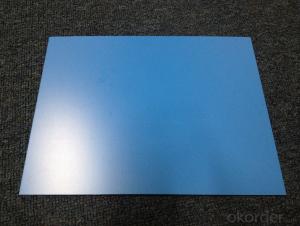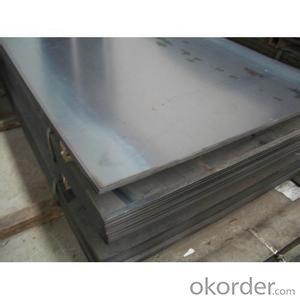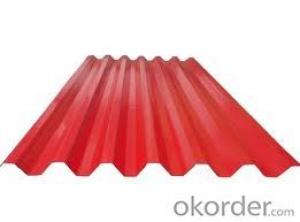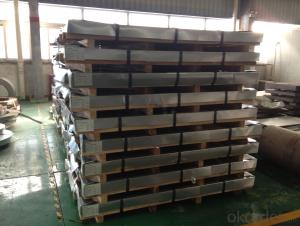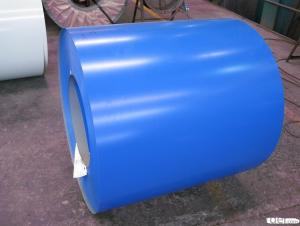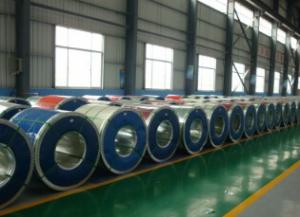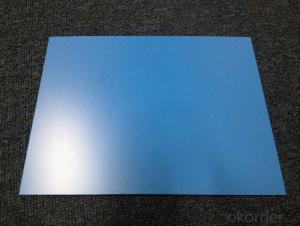PRE-PAINTED ALUZINC STEEL SHEET
- Loading Port:
- Tianjin
- Payment Terms:
- TT OR LC
- Min Order Qty:
- -
- Supply Capability:
- 8000 m.t./month
OKorder Service Pledge
Quality Product, Order Online Tracking, Timely Delivery
OKorder Financial Service
Credit Rating, Credit Services, Credit Purchasing
You Might Also Like
THICKNESS:0.18mm-1.5mm
WIDTH:900mm-1250mm
COATING MASS:AZ30-AZ180
PAINT:PE、HP、HDP、PVDF、SMP、MATT、PVDF
COLOR:RAL Scale
COIL INNER DIAMETER:508mm/610mm
COIL WEIGHT:3mt-7mt
BASE MATERIAL:Hot-dip Aluzinc Steel
- Q: What are the most common thicknesses of steel sheets?
- The most common thicknesses of steel sheets vary depending on the intended application and industry standards. However, some commonly used thicknesses include 0.035 inches (20 gauge), 0.0478 inches (18 gauge), 0.0598 inches (16 gauge), 0.0747 inches (14 gauge), and 0.1046 inches (10 gauge). These thicknesses are frequently used in construction, automotive, manufacturing, and other industries. Additionally, thinner gauges such as 0.0239 inches (24 gauge) and 0.0299 inches (22 gauge) may be used for lighter applications or where weight reduction is a priority. Ultimately, the specific thickness of steel sheets chosen will depend on the specific requirements of the project and the structural integrity needed.
- Q: What are the different embossing options available for steel sheets?
- There are several embossing options available for steel sheets, including blind embossing, deep embossing, pattern embossing, and textured embossing.
- Q: What are the common sizes of steel sheets?
- The common sizes of steel sheets vary depending on the specific application and industry. However, some common standard sizes include 4x8 feet, 4x10 feet, and 5x10 feet. These dimensions provide a general idea, but it's important to note that steel sheets can be customized to meet specific requirements.
- Q: Can steel sheets be used for heat exchangers or boilers?
- Yes, steel sheets can be used for heat exchangers or boilers. Steel is a commonly used material for these applications due to its excellent thermal conductivity, high strength, and resistance to corrosion at high temperatures.
- Q: Can steel sheets be used for manufacturing automotive parts?
- Yes, steel sheets can be used for manufacturing automotive parts. Steel is a commonly used material in the automotive industry due to its strength, durability, and cost-effectiveness. Steel sheets can be formed and shaped into various automotive components like body panels, chassis parts, and structural reinforcements. Additionally, steel offers excellent crash resistance and can withstand high temperatures, making it suitable for automotive applications.
- Q: Are the steel sheets available in different grades?
- Yes, steel sheets are available in different grades.
- Q: How do steel sheets perform in fire-rated applications?
- Steel sheets perform exceptionally well in fire-rated applications. Due to their high melting point and excellent heat resistance, they offer superior protection against fire and help to contain its spread. Steel sheets are widely used in fire-rated walls, doors, and ceilings, as they maintain their structural integrity even at extremely high temperatures. Additionally, they contribute to fire safety by limiting the release of toxic gases and smoke, making them a reliable choice for fire protection in various industries and buildings.
- Q: How do steel sheets handle vibrations?
- Steel sheets have gained a reputation for their exceptional capacity to manage vibrations, primarily due to their high stiffness and strength. When exposed to vibrations, steel sheets have a tendency to absorb and diminish the energy of the vibration, thereby minimizing the transmission of these vibrations to other components of a structure or system. The inherent characteristics of steel, namely its high modulus of elasticity and limited damping capacity, play a significant role in its effectiveness in handling vibrations. The elevated modulus of elasticity allows steel sheets to resist deformation when subjected to external forces, thereby ensuring the maintenance of their structural integrity and stability during vibrations. Furthermore, the low damping capacity of steel allows it to efficiently dissipate the energy of the vibration, effectively preventing excessive oscillations or resonance. Steel sheets find widespread use in numerous applications that require resistance to vibrations, including industrial machinery, automotive components, and building structures. Their durability and dependable ability to handle vibrations make them a preferred choice in such scenarios. However, it should be noted that the specific performance of steel sheets in managing vibrations may vary depending on factors such as the thickness of the sheets, material composition, and design considerations.
- Q: What is the typical load-bearing capacity of a steel sheet?
- The typical load-bearing capacity of a steel sheet can vary depending on its thickness, grade of steel, and how it is supported. However, on average, a standard steel sheet can typically bear loads ranging from 5,000 to 20,000 pounds per square inch.
- Q: Can steel sheets be used for reinforcing concrete structures?
- Yes, steel sheets can be used for reinforcing concrete structures. They are commonly used as reinforcement in concrete construction due to their high strength, durability, and ability to withstand high loads and provide structural support. Steel sheets are often used to reinforce concrete walls, slabs, beams, and columns, enhancing the overall strength and stability of the structure.
Send your message to us
PRE-PAINTED ALUZINC STEEL SHEET
- Loading Port:
- Tianjin
- Payment Terms:
- TT OR LC
- Min Order Qty:
- -
- Supply Capability:
- 8000 m.t./month
OKorder Service Pledge
Quality Product, Order Online Tracking, Timely Delivery
OKorder Financial Service
Credit Rating, Credit Services, Credit Purchasing
Similar products
Hot products
Hot Searches
Related keywords
